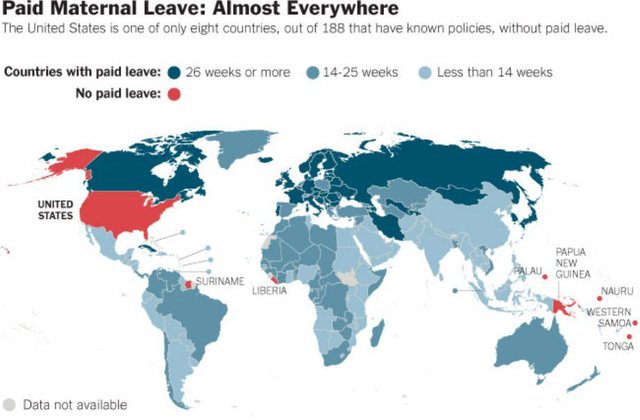The United States may be one of the richest countries in the world, but in a key figure it ranks last at all: it is the only rich country in the world that offers no national paid maternity leave program. Today, only 21 percent of American workers have access to family vacations paid through their employers, although, according to the Pea Research Center in 2015, both parents work full-time in almost half of two-parent households.
This lack of maternity leave provisions stands in stark contrast to European countries, where subsidized parental leave is standard. Research has shown that paid parental leave offers undeniable benefits to parents, children and the societies of the countries that provide it. There is also widespread support for him in U.S. society; according to an academic study published in April, about 82% of Americans support paid maternity leave entry. This figure has remained roughly the same for years and includes support from across the political spectrum.
The reasons the U.S. remains outside paid maternity leave schemes are complex, combining post-World War II needs with a complex national cultural identity of individualism and self-determination. Now, however, there is a significant impetus for change. In April, U.S. President Joe Biden proposed a $ 225 billion package for paid family and medical leave that would allow workers to take up to 12 weeks of paid leave to care for a newborn member. or another family member.
In a state that feels more polarized than ever, the data show that paid maternity leave is a rare issue that voters on all sides can leave behind. So why has nothing been approved at the national level so far, even with Biden’s plan on his way to Congress, can it really be done this time?
Two roads that separate
Globally, the basis for national paid maternity leave was laid by the International Congress of Working Women in 1919, a group that included many American women.
The group’s demands for fairer labor standards on the eve of World War I included 12 weeks of paid maternity leave as “a medical necessity and a social right,” a policy adopted by the International Labor Organization in November 1919.
Over the next two decades, European and Latin American countries began to incorporate these policies into law, but it was the end of World War II that entrenched the process, especially in Europe. Part of it had to do with the fear of demographic decline, just the huge population loss during World War II and what felt like a need to recover from those years and ensure that there was a workforce for the future .
Simply put, Europe needed new populations to help repopulate war-torn states and a workforce to rebuild economies. During this post-war era the European arguments for nationally paid maternity leave were formulated primarily in economic terms rather than about the social benefits we focus on today.
However, the post-war landscape looked a little different in the US. “We did not have the same fear of the need for population growth,” said Joya Misra, a professor of sociology and public policy at the University of Massachusetts. The country had not suffered such large population losses in the war, the economy was doing well and immigration and labor were consolidating.
This meant that mothers in the US “were being encouraged to return home, to vacate the jobs their husbands would now need to return from the conflict, and to become housewives raising families,” says Terry Boyer, Founding Director by Anne Welsh McNulty Institute for Women Leadership at Villanova University, USA
Post-war trauma and divergent strategies
The extreme political ideologies that had emerged globally influenced the way states designed welfare policies in the post-war period. Both the US and the states in Western Europe wanted to strengthen democratic traditions after the trauma of World War II, but they took different approaches.
European states had experienced the effects of fascism directly, and from this trauma arose a feeling that the social philosophy of ‘each man for himself’ was “very alienated and left people vulnerable to extreme ideologies.”
This led to widespread political support for a welfare state as a means to establish the social and economic stability and solidarity needed to support democracy. The UK economic stagnation, for example, came along with reforms that built up public health care and workers’ pensions.
The US, however, doubled in its individualistic cultural way, especially as its relationship with the Soviet Union deteriorated after the war. After that, the “strong antipathy” to anything that could be labeled socialist, or worse, communist, made it much more difficult to build support for universally beneficial social welfare policies.
What and to whom is the work valued?
American individualism is nurtured by the perception of the social and economic value of maternity leave.
In Europe, paid maternity leave often went hand in hand with public health care and state-provided primary education through which parents could make early connections with their children, and then return to the workforce while the children of them received a strong education.
But in the US, paid maternity leave was viewed with more suspicion; instead of a way to keep people in the paid labor force as they retired, many saw it as “a right that people will enjoy to get money from government-funded businesses and taxpayers.
This view was rooted in the way different types of work and indeed people were valued in the post-war years, and in the idea that securing paid universal maternity leave could encourage “wrong” families to reproduce.
Parts of the U.S. workforce are still largely segregated along racial lines, with far more low-wage services and agricultural work still held by minorities. Only 8% of low-wage workers (usually less than $ 14 an hour) had access to paid parental leave in 2020.
Today, it is not uncommon to see comments about the idea that poor families should not receive government support because it is ‘their fault that they are poor’. “Racism played a major role in how we put it,” she added. “And once it is decided, it becomes very difficult to separate it,” says Misra
Change on the horizon?
Right now, says Misra, the US has a “political window” to make changes because of how the Covid-19 pandemic has ruthlessly exposed gender inequalities, job security and childcare. Since the pandemic, more than 3 million women have left the U.S. workforce. As a result, people are waking up to the economic benefits of wider social support for families.
Mental health is also in the spotlight more than ever. Pre-Covid-19, an inability to “balance everything” can be seen as a personal failure by mothers, rather than a structural problem that needs to be addressed by politics. But, there is growing awareness especially among younger workers that more support is needed to help parents with an uncontrollable workload.
Mandating a nationally paid maternity leave would have numerous benefits. Whether Biden’s initiatives can pass remains to be seen and even supporters like Misra are unsure.
“I think my hesitation has to do with the partisan way politics operates,” she says, citing the use of filibuster as a last but effective means of blocking legislation. There are ways around it, but it can lead to the approval of the bill without vital guarantees for the workers that their jobs will be protected.
“The pandemic has been extremely devastating in many ways, but with destruction always comes construction because you have to understand how to put the system back together,” she added.







